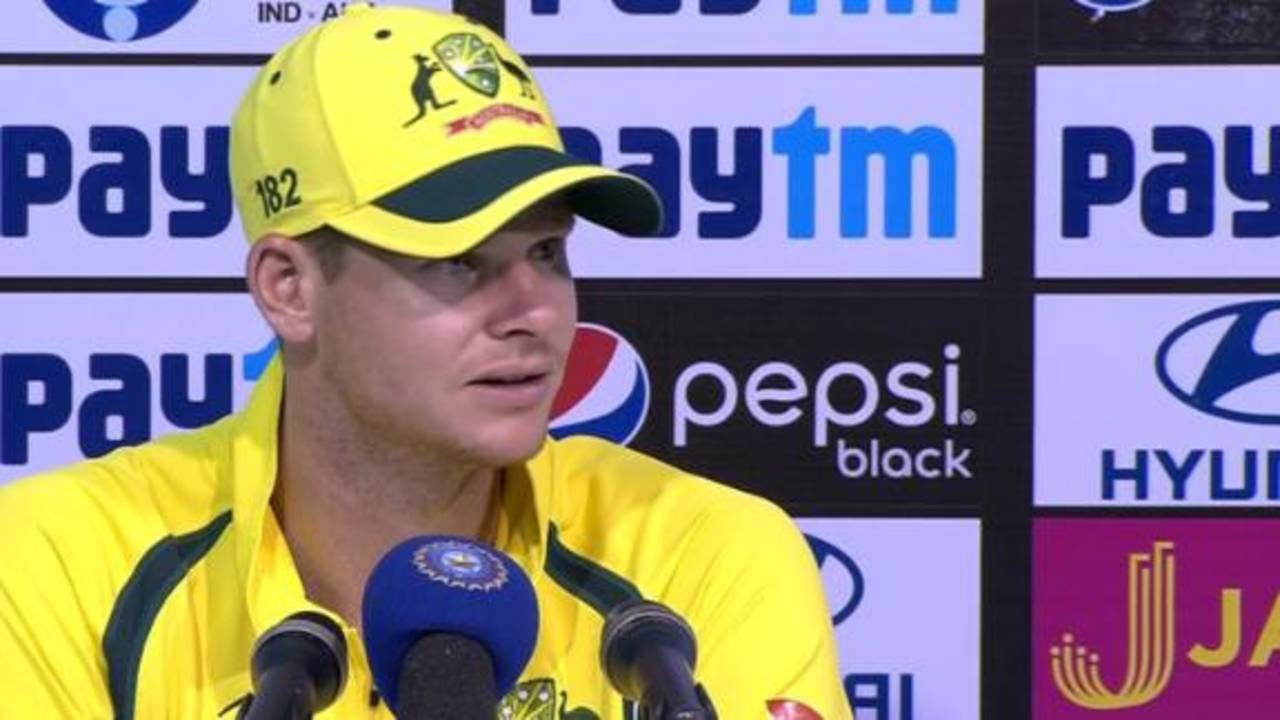Indian batting depth raises Ashes alarm
Over-experimentation in the middle overs undid the early damage inflicted by the pacers, says Australia captain
Daniel Brettig
18-Sep-2017
Depth is a concept that Australia can expect to wrestle with during the Ashes, in the sense that England's batting order has it and Steven Smith's side, for the time being, does not. In Chennai, Smith's ODI team got an early taste of what that can look like, albeit in circumstances that allowed some room for benefit of the doubt.
With the new ball, Nathan Coulter-Nile and Pat Cummins started exceptionally well, bowling fast, on the ideal length and with enough movement to prompt errors from India's top four. Marcus Stoinis then followed up by "bashing the wicket" and coaxing out a couple victims of his own to cross-bat shots.
However those early gains gave way to more indifferent bowling through the middle of the innings, as India showcased the depth - that word again - they have added to their batting order in limited overs matches through the regeneration of MS Dhoni and the allround ability of Hardik Pandya. Dropped catches helped too, but India still had to capitalise, something Dhoni and Pandya did in grand style, the former savaging the recalled James Faulkner, after the latter had swung freely at Adam Zampa's flat, full wrist spin.
"I think we probably we went away from our plans a little bit," Smith said. "We were hitting such a good length and certainly persisted with that for a while with the good bouncers we were bowling. We were trying too many things, too many slower balls, just not hitting that good hard length we were hit early on.
"The message to Zampa as well was to bring his length back a bit. He was bowling very full and Hardik looked like hitting everyone of those for a six. As soon as he got his length back a bit and made him go across the ball, he got him out. He just bowled a fraction full and paid the price."
Depth in batting tests a bowling unit in this manner. Second and third spells are required, wickets must be coaxed from old balls as well as new, concentration and discipline must be maintained for longer periods than an initial burst. Granted plenty of overs in which to right the ship, Dhoni and Pandya proved capable of playing a longer game than Australia's bowlers. It was an episode that could not help but be noticed by England, particularly its lower middle order trio of Jonny Bairstow, Ben Stokes and Moeen Ali.
"That partnership changed the game," Smith said. "They put on 120-odd and took them from 87 to 206. In the end that proved to be a match-winning partnership. Unfortunately we weren't able to capitalise on the start we had. We started very well with the new ball. That's a positive for us. One thing we have been working on.
"Over the last 18 months, we haven't started well with the new ball, we haven't been able to draw things back. I thought we bowled to the conditions and bowled to the right areas."
When rain arrived between innings, reducing Australia's allotment of overs to 21 and their target to 164, the time afforded to Dhoni and Pandya was sheared away from the touring middle order. This was doubly unfortunate, as the same inclement weather that reduced the overs also helped create an ideal environment for India's seamers Bhuvneshwar Kumar, Jasprit Bumrah and Pandya himself. By the time the early overs had seen a tit-for-tat loss of Australian top order wickets not dissimilar to India's, there was very little room for the middle order to manoeuvre in.
"It was never going to be easy chasing 160 with two new balls. It was sort of a good new ball wicket to bowl with," Smith said. "We could have perhaps played a little bit differently and try to take a little bit more time upfront. It's always hard in 20 overs to judge that. We weren't good enough. Batting for 20 overs is difficult when you are losing wickets. Trying to go hard, it didn't work out as we would have liked. Hopefully we would turn things around in a couple of days in Kolkata.
"I think 160 with one new ball would have made things a lot easier. When you have two new balls from both ends, as you saw the whole game, we took three wickets with the new ball and they found it quite hard. It was the same for us. When you are playing 20 overs, you don't have a great deal of time to make things up. You need eight an over basically from ball one. It was difficult in that aspect. Perhaps we could have been a little bit more defensive at the start, keep wickets in hand and harder later."
Stacked as it is with allrounders, Australia's limited overs batting order is deeper than the Test match equivalent. They will hope that next time around the weather will not intervene at an awkward juncture. but at the same time, Smith will know that success for his teams this summer will relate very much to whether they can persist for longer periods than in Chennai - India now, and England in coming months, both have the depth to test Australian endurance.
Daniel Brettig is an assistant editor at ESPNcricinfo. @danbrettig
